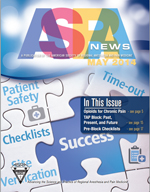This post has also been featured on KevinMD.com.
Imagine — where would elective surgery be today if patients still worried about operating rooms exploding or developing liver and kidney failure from anesthesia?
Having major surgery would be a very different experience without anesthesia. Before the advent of safe anesthesia techniques, the world of surgery was basically limited to amputations and other attempts at life-saving maneuvers. Dr. Bigelow’s publication describing the safe administration of ether changed everything, and the New England Journal of Medicine called this the most important article in its history. With this article, the science and clinical practice of anesthesiology, as well as the modern era of surgery, were born.
How is “anesthesiology” different than “anesthesia?” Anesthesiology is a science like biology or physiology and a field of medicine like cardiology or radiology. Anesthesia, a word with Greek origin, means “without sensation.” There are different types of practitioners who can administer anesthesia, but not all of them are anesthesiologists. The heart of anesthesiology continues to be the patient experience. As anesthesiologists, we are physicians who specialize in relieving anxiety, preventing and treating pain, preventing and managing complications related to surgery, and improving the outcomes for patients who undergo invasive procedures. Not only are we clinicians who apply the best available evidence in our patient care practice; we are the physicians and scientists who develop the evidence. The clinical practice of delivering anesthesia should not take place without the involvement of anesthesiologists.
Often referred to as “going to sleep,” general anesthesia itself is actually not that simple. In fact, there is a lot of science behind the turning of dials that many patients and providers take for granted. Anesthetic agents have not always been as safe as they are today, and anesthesiologists were responsible for conducting important research to retire some of the anesthetics that had the potential to cause patients harm. Thanks to anesthesiologists, we have fast-acting and safe anesthetic gases that have facilitated the evolution of same-day outpatient procedures.
One study that has guided my practice was conducted by my residency advisor, Dr. Alex Macario. His research team surveyed patients having elective surgery to ask them which adverse effects of anesthesia they wish to avoid most. The answers are a little surprising. Two of the top 4 items are nausea and vomiting, with vomiting being #1. To improve the experience for patients undergoing anesthesia, anesthesiologists have studied medications that prevent nausea and vomiting after surgery and have established practice guidelines to share their recommendations with anesthesia providers and patients everywhere.
My own research has focused on developing safe pain management techniques for patients having surgery that decreases the need for narcotics. Like other anesthesiologists before me, I have studied target-specific pain relief techniques using local anesthetic nerve blocks that allow patients to recover at home instead of staying in the hospital for pain control after surgery. What does this mean for you as a patient? It means sleeping better in your own bed in your own house instead of in the hospital. It means using less narcotic pain medication and avoiding the side effects like nausea and constipation that come with it. It means that family members who take care of you at home can do this more easily, and they need to take less time off work. It means that you as a patient can recover more quickly and get back to doing the things you want to do.
I apply my research results and the results of other anesthesiologists’ research studies to my clinical practice every day. I don’t pretend to have all the answers, and I am very wary of those who say they do. Like many of my anesthesiology colleagues, I see potential research questions and opportunities to improve the surgical experience in daily patient care activities, and I am fortunate to work in an environment that supports investigation and inspires innovation.
I have been told that it is difficult sometimes to distinguish an anesthesiologist from other anesthesia providers by what we wear and how we look. That may be true, but there is something special about how anesthesiologists think — how we perceive clinical information, analyze it, interpret it, and apply it — that patients need to know.
Anesthesiologists, working alone or in a care team model supervising other anesthesia providers, bring their expertise to the bedside to improve the patient experience. There has been growing pressure recently to abandon the team model and remove the need for nurse anesthetist supervision. Why are patients and surgeons being forced to choose between having a nurse anesthetist OR an anesthesiologist when they shouldn’t have to? Given the choice, I think they will choose “AND.”
Facebook
LinkedIn
Pinterest
E-mail
Related Posts:








 The application cycle for the 2014-15 Stanford Regional Anesthesiology and Acute Pain Medicine Fellowship class is still open for 1 off-cycle spot scheduled to start in Winter 2015. The application cycle for 2015-16 is also open now and will remain open until Summer 2014.
The application cycle for the 2014-15 Stanford Regional Anesthesiology and Acute Pain Medicine Fellowship class is still open for 1 off-cycle spot scheduled to start in Winter 2015. The application cycle for 2015-16 is also open now and will remain open until Summer 2014. ternet, it is more important than ever for us to reach out to them.
ternet, it is more important than ever for us to reach out to them.